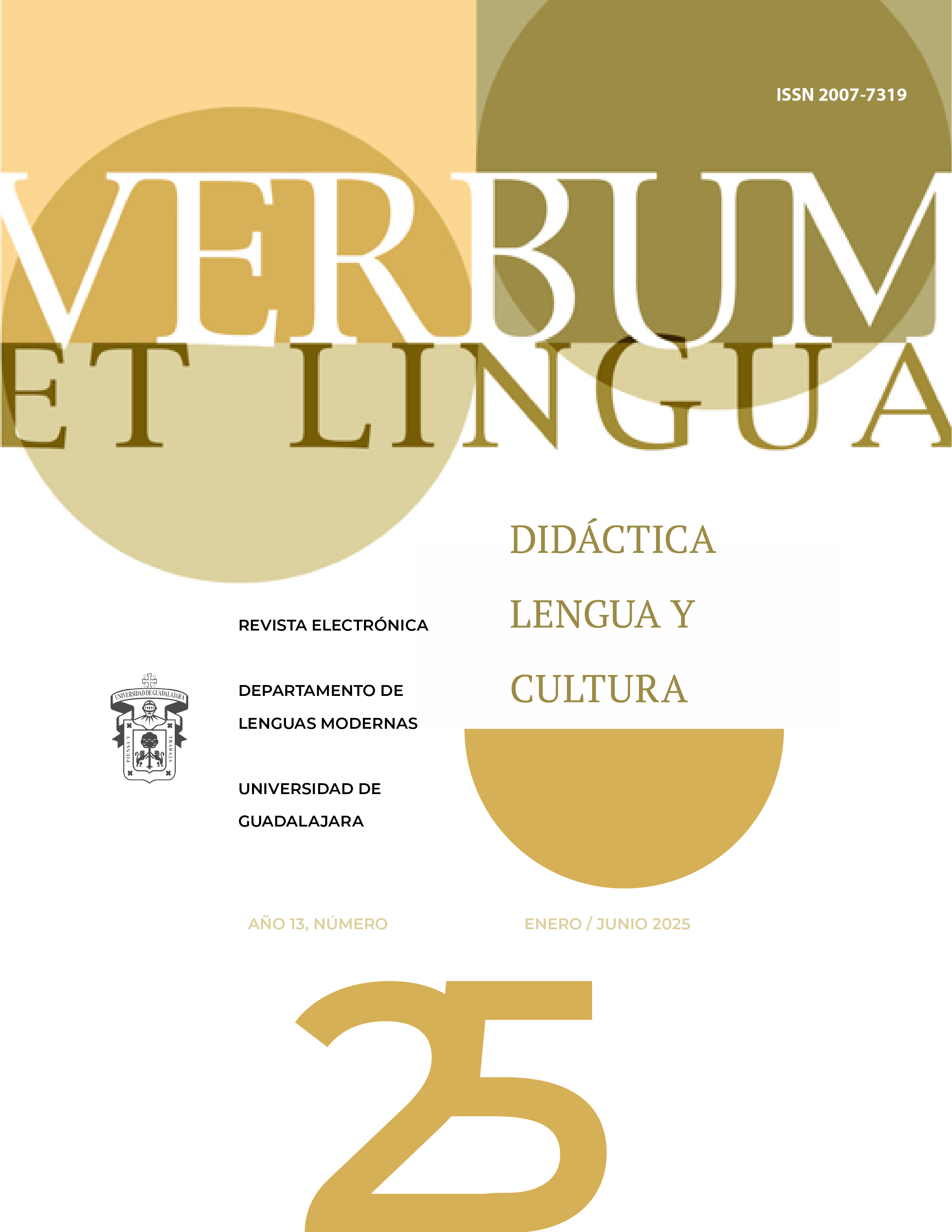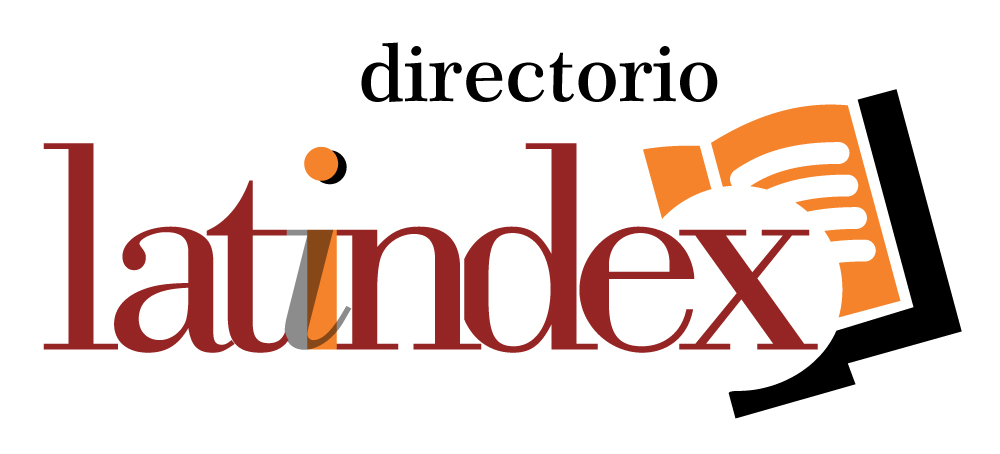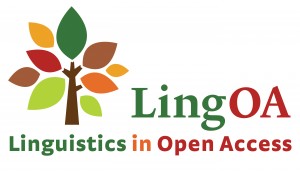Trastorno especifico del lenguaje y tipología lingüística: Revisión Narrativa
DOI:
https://doi.org/10.32870/vel.vi25.299Schlagworte:
Trastornos del lenguaje, Trastorno específico del lenguaje, Tipología lingüística, Revisión narrativa, PsicolingüísticaAbstract
El presente trabajo busca identificar las diferencias y similitudes en las narraciones de niños con Trastorno Específico del Lenguaje (TEL) en distintas lenguas para encontrar patrones a través de la tipología lingüística que faciliten la clasificación y el diagnóstico del mismo. La tipología lingüística estudia las lenguas a partir de sus características formales, para encontrar patrones generalizables que expliquen su funcionamiento. Esto puede ser de gran utilidad en el estudio del TEL, que se caracteriza por las dificultades en adquisición, producción y compresión de las habilidades lingüísticas, por ende, las áreas afectadas dependen de las características de la lengua del hablante. Se hizo una revisión narrativa con 19 artículos de siete lenguas con diferentes tipologías (español, finés, ruso, holandés, inglés, cantonés y mandarín), poniendo atención en los marcadores específicos de TEL y comparando su presencia-ausencia con las otras lenguas. Se identifica menor complejidad sintáctica, menor diversidad léxica y menor longitud de oraciones en las producciones de niños con TEL, aunque en distinta medida, lo cual podrían interpretarse como un marcador persistente en el habla de los niños con TEL. Los resultados no son concluyentes, ya que los artículos no realizan descripciones lingüísticas completas y difieren en la forma de elicitación de las narraciones. Pero, los datos apoyan la posibilidad de que pueden encontrarse marcadores básicos para el TEL cuando se use una metodología basada en el reconocimiento de las diferentes tipologías lingüísticas con descripciones minuciosas de los elementos lingüísticos.Downloads
Metriken
Literaturhinweise
Auza B, A.; Towle Harmon, M., & Murata, C. (2018). Retelling stories: Grammatical and lexical measures for identifying monolingual Spanish speaking children with specific language impairment (SLI). Journal of Communication Disorders, 71, 52-60. https://doi.org/10.1016/j.jcomdis.2017.12.001
Bal?i?nien?, I. & Kornev, A. N. (2016). Doing new things with language: Narrative language in SLI preschoolers. Eesti Rakenduslingvistika Ühingu aastaraamat= Estonian Papers in Applied Linguistics. Tallinn: Eesti Keele Sihtasutus, 12, 25-42. http://arhiiv.rakenduslingvistika.ee/ajakirjad/index.php/aastaraamat/article/view/ERYa12.02
Bishop, D., Snowling, M., Thompson, P. & Greenhalgh, T. (2016). CATALISE: A multinational and multidisciplinary Delphi consensus study. Identifying language impairments in children. PLOS one, 11(7). https://doi.org/10.1371/journal.pone.0158753
Coloma, C.J., Araya, C., Quezada, C., Pavez, M.M., Álvarez, C., & Maggiolo, M. (2019). Development of grammaticality and sentence complexity in monolingual Spanish Speaking children with specific language impairment: An exploratory study. Sintagma, Revista de Lingüística, 31, 87-101. https://dialnet.unirioja.es/servlet/articulo?codigo=7224385
Colozzo, P.; Gillam, R.B.; Wood, M.; Schnell, R.D., & Johnston, J.R. (2011). Content and Form in the Narratives of Children with Specific Language Impairment. Journal of Speech, Language, and Hearing Research: JSLHR, 54(6), 1609–1627. https://doi.org/10.1044/1092-4388(2011/10-0247)
Comrie, B. (2001). Different views of language typology. En M. Haspelmath, E. König, W. Oesterreicher & W. Raible (Eds.). Language Typology and Language Universals. An International Handbook (Vol. 1, pp. 25-39). Gruyter.
Crago, M., Paradis, J., & Menn, L. (2008). Cross-linguistics Perspectives on the Syntax and Semantics of Language Disorders. En M.J. Ball, M.R. Perkins, N. Müller, & S. Howard (Eds.). The Handbook of Clinical Linguistics (pp. 275-289). Blackwell.
Duinmeijer, I., de Jong, J., & Scheper, A. (2012). Narrative abilities, memory, and attention in children with a specific language impairment. International Journal of Language & Communication Disorders, 47(5), 542-555.https://doi.org/10.1111/j.1460-6984.2012.00164.x
Duman, Y. T., Blom, E., & Topba?, S. (2015). At the intersection of cognition and grammar: deficits comprehending counterfactuals in Turkish children with specific language impairment. Journal of Speech, Language, and Hearing Research, 58(2), 410-421.https://doi.org/10.1044/2015_JSLHR-L-14-0054
Duman, Y. T., & Topba?, S. (2016). Epistemic uncertainty: Turkish children with specific language impairment and their comprehension of tense and aspect. International Journal of Language & Communication Disorders, 51(6), 732-744.https://doi.org/10.1111/1460-6984.12244
Fresneda, M.D., & Mendoza, E. (2005). Trastorno específico del lenguaje: Concepto, clasificaciones y criterios de identificación. Revista de Neurología, 41 (1), 51-56. https://doi.org/10.33588/rn.41S01.2005317
Håkansson, G. (2017). Typological and developmental considerations on specific language impairment in monolingual and bilingual children: A Processability Theory account. Language Acquisition, 24(3), 265–280. https://doi.org/10.1080/10489223.2016.1192634
Harris, A. & Xu, Z. (2006). Diachronic Morphological Typology. En K. Brown (Ed.). Encyclopedia of Language and Linguistics (2nd ed., pp.509-515). https://doi.org/10.1016/B0-08-044854-2/00186-3
Hincapié-Henao, L. Giraldo-Prieto, M., Lopera-Restrepo, F., Pineda-Salazar, D. A., Castro-Rebolledo, R., Lopera-Vásquez, J. P., ... & Lopera-Echeverri, E. (2008). Trastorno Específico del Desarrollo del Lenguaje en una población infantil colombiana. Universitase Psychologica, 7(2),557-569.
Iacobini, C. (2006). Morphological Typology. En K. Brown (Ed.). Encyclopedia of Language and Linguistics (2nd ed., pp. 278-282). Elsevier Science.
Iao, L. S., Ng, L. Y., Wong, A. M. Y., & Lee, O. T. (2017). Nonadjacent dependency learning in Cantonese-speaking children with and without a history of specific language impairment. Journal of Speech, Language, and Hearing Research, 60(3), 694-700.https://doi.org/10.1044/2016_JSLHR-L-15-0232
Kunnari, S., Savinainen-Makkonen, T., Leonard, L. B., Mäkinen, L., Tolonen, A. K., Luotonen, M., & Leinonen, E. (2011). Children with specific language impairment in Finnish: The use of tense and agreement inflections. Journal of Child Language, 38(5), 999-1027. https://doi.org/10.1017/S0305000910000528
Kunnari, S., Savinainen-Makkonen, T., Leonard, L. B., Mäkinen, L., & Tolonen, A. K. (2014). The use of negative inflections by Finnish-speaking children with and without specific language impairment. Clinical Linguistics & Phonetics, 28(9), 697-708.https://doi.org/10.3109/02699206.2014.886725
Leonard, L. B. (2014). Specific language impairment across languages. Child development perspectives, 8(1), 1-5. https://doi.org/10.1111/cdep.12053
Mäkinen, L., Loukusa, S., Laukkanen, P., Leinonen, E., & Kunnari, S. (2014). Linguistic and pragmatic aspects of narration in Finnish typically developing children and children with specific language impairment. Clinical Linguistics & Phonetics, 28(6), 413-427.https://doi.org/10.3109/02699206.2013.875592
Moravcsik, E. A. (2013) Introducing Language Typology, Cambridge University Press.
Moreno Cabrera, J. C. (2003). Síntesis y análisis en las lenguas: crítica de la tipología morfológica clásica y de algunas de sus aplicaciones sincrónicas y diacrónicas. ELUA. Estudios de Lingüística (17), 465-504.http://dx.doi.org/10.14198/ELUA2003.17.26
Moseley, C. (2006). Russian Federation: Language Situation. En K. Brown (Ed.) Encyclopedia of Language and Linguistics (2nd ed., pp. 698-701). Elsevier Science.
Packard, J.L (2006). Chinese as an Isolating Language. En K. Brown (Ed.) Encyclopedia of Language and Linguistics (2nd ed., pp. 355-358). Elsevier Science.
Pearce, W. M., James, D. G., & McCormack, P. F. (2010). A comparison of oral narratives in children with specific language and non-specific language impairment. Clinical Linguistics & Phonetics, 24(8), 622-645.https://doi.org/10.3109/02699201003736403
Petersen, D. B., & Gardner, C. M. (2011). Trastorno Específico del Lenguaje: una revisión. Revista Chilena de Fonoaudiología, 10, 19-32.https://doi.org/10.5354/rcdf.v10i0.17348
Rothweiler, M., Chilla, S., & Babur, E. (2010). Specific language impairment in Turkish: Evidence from case morphology in Turkish–German successive bilinguals. Clinical Linguistics & Phonetics, 24(7), 540-555.https://doi.org/10.3109/02699200903545328
Sauerland, U., Grohmann, K. K., Guasti, M. T., An?elkovi?, D., Argus, R., Armon-Lotem, S., Arosio, F., Avram, L., Costa, J., Dabašinskien?, I., De López, K., Gatt, D., Grech, H., Haman, E., Van Hout, A., Hrzica, G., Kainhofer, J., Kamandulyt?-Merfeldien?, L., Kunnari, S., … Yatsushiro, K. (2016). How do 5-year-olds understand questions? Differences in languages across Europe. First Language, 36(3), 169–202. https://doi.org/10.1177/0142723716640236
Sheng, L., & McGregor, K. K. (2010). Object and action naming in children with specific language impairment. Journal of Speech, Language, and Hearing Research, 53(6), 1704-1719. https://doi.org/10.1044/1092-4388(2010/09-0180)
Swan, M. (2006). English in the Present Day (Since ca. 1900). En K. Brown (Ed.). Encyclopedia of Language and Linguistics (2nd ed. pp: 149-156). Elsevier Science.
Tribushinina, E., & Dubinkina, E. (2012). Adjective production by Russian-speaking children with specific language impairment. Clinical Linguistics & Phonetics, 26(6), 554-571. https://doi.org/10.3109/02699206.2012.666779
Tribushinina, E., Dubinkina, E., & Sanders, T. (2015). Can connective use differentiate between children with and without specific language impairment? First Language, 35(1), 3-26. https://doi.org/10.1177/01427237145663
Tsai, W. y Chang, C. (2008). “But I first… and then he kept picking”: Narrative skill in Mandarin-speaking children with language impairment. Narrative Inquiry, 18(2), 349-377.https://doi.org/10.1075/ni.18.2.09tsa
To, CKS; Stokes, SF; Cheung, HT; T'sou, BKY (2010) Narrative assessment for Cantonese-speaking children. Journal of Speech, Language, and Hearing Research, 53, (3), 648–669. https://doi.org/10.1044/1092-4388(2009/08-0039)
Torng, P. & Sah, W. (2020) Narrative abilities of Mandarin-speaking children with and without specific language impairment: macrostructure and microstructure. Clinical Linguistics & Phonetics,34(5) 453-478.https://doi.org/10.1080/02699206.2019.1655097
Ward, D. (2006). Russian. En K. Brown (Ed.) Encyclopedia of Language and Linguistics (2nd ed., pp695- 698). Elsevier Science.
Wong, A., Klee, T., Stokes, S.F., Fletcher, P. & Leonard, L.B. (2010). Differentiating Cantonese-speaking preschool children with and without SLI using MLU and lexical diversity (D). Journal of Speech, Language, and Hearing Research, 53(3), 794-799. https://doi.org/10.1044/1092-4388(2009/08-0195)
Zwitserlood, R., van Weerdenburg, M., Verhoeven, L., & Wijnen, F. (2015). Development of morphosyntactic accuracy and grammatical complexity in Dutch school-age children with SLI. Journal of Speech, Language, and Hearing Research, 58(3), 891-905. https://doi.org/10.1044/2015_JSLHR-L-14-0015
Downloads
Veröffentlicht
Versionen
- 2025-08-13 (3)
- 2025-02-21 (2)
- 2025-02-12 (1)













